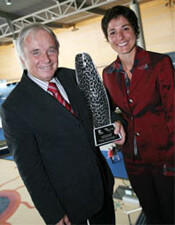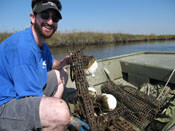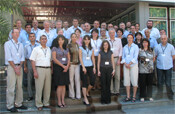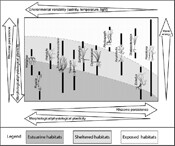International Commission for the Protection of the Danube River wins the 2007 International Thiess Riverprize
 A groundbreaking Austrian river management project has won the prestigious AUD$300,000 (US$262,000) International Thiess Riverprize - the world's largest prize in its field. The Thiess Riverprize was announced at a special gala ceremony on Tuesday 4 September during the 10th International Riversymposium & Environmental Flows Conference held in Brisbane, Australia. The Danube River project, initiated by the International Commission for the Protection of the Danube River (ICPDR), was awarded the Australian-based prize for its collaborative approach to improve water quality in Europe's second longest river. The Riversymposium was attended by Bill Dennison and Jane Thomas from IAN, and Ben Longstaff from EcoCheck.
A groundbreaking Austrian river management project has won the prestigious AUD$300,000 (US$262,000) International Thiess Riverprize - the world's largest prize in its field. The Thiess Riverprize was announced at a special gala ceremony on Tuesday 4 September during the 10th International Riversymposium & Environmental Flows Conference held in Brisbane, Australia. The Danube River project, initiated by the International Commission for the Protection of the Danube River (ICPDR), was awarded the Australian-based prize for its collaborative approach to improve water quality in Europe's second longest river. The Riversymposium was attended by Bill Dennison and Jane Thomas from IAN, and Ben Longstaff from EcoCheck.
Report on linking stable nitrogen isotopes in oyster bioindicator to land use
 IAN graduate student Ben Fertig took to the field at Monie Bay (Somerset County, MD). As a National Estuarine Research Reserve Graduate Research Fellow, he is focusing on linking stable nitrogen isotopes in deployed oyster tissues to local land use in three tributary creeks. Nitrogen from both internal and external sources relative to the Monie Bay watershed was found. Ben continues to explore the potential of the native eastern oyster, Crassostrea virginica, to determine and monitor nutrient sources to augment conventional water quality monitoring.
IAN graduate student Ben Fertig took to the field at Monie Bay (Somerset County, MD). As a National Estuarine Research Reserve Graduate Research Fellow, he is focusing on linking stable nitrogen isotopes in deployed oyster tissues to local land use in three tributary creeks. Nitrogen from both internal and external sources relative to the Monie Bay watershed was found. Ben continues to explore the potential of the native eastern oyster, Crassostrea virginica, to determine and monitor nutrient sources to augment conventional water quality monitoring.
Integrated Water Resource Management in the South Caucasus, Georgia September 2007
 IAN was asked to participate in a recent workshop run by the South Caucasus Water Program. Tim Carruthers presented some approaches to data syntheses and particularly the potential to develop a report card for water quality in the Kura Basin. The Kura River provides essential water resources to three countries: Georgia, Armenia, and Azerbaijan, and the aim of this USAID project is to work towards joint monitoring and management of these shared water resources.
IAN was asked to participate in a recent workshop run by the South Caucasus Water Program. Tim Carruthers presented some approaches to data syntheses and particularly the potential to develop a report card for water quality in the Kura Basin. The Kura River provides essential water resources to three countries: Georgia, Armenia, and Azerbaijan, and the aim of this USAID project is to work towards joint monitoring and management of these shared water resources.
Seagrasses of south-west Australia: A conceptual synthesis of the world's most diverse and extensive seagrass meadows
 Compared to global seagrass meadows, coastal south-west Australian seagrass habitats experience high light, low nutrients, and high water movement. Despite these differences, similarities with other regions do exist and here we place the habitats of south-west Australia into a global context using comparative data. This paper, co-authored by IAN staff, is a product of an NCEAS synthesis on global seagrass trajectories and appears in a special 2007 issue of the Journal of Experimental Marine Biology and Ecology 350: 21-45.
Compared to global seagrass meadows, coastal south-west Australian seagrass habitats experience high light, low nutrients, and high water movement. Despite these differences, similarities with other regions do exist and here we place the habitats of south-west Australia into a global context using comparative data. This paper, co-authored by IAN staff, is a product of an NCEAS synthesis on global seagrass trajectories and appears in a special 2007 issue of the Journal of Experimental Marine Biology and Ecology 350: 21-45.